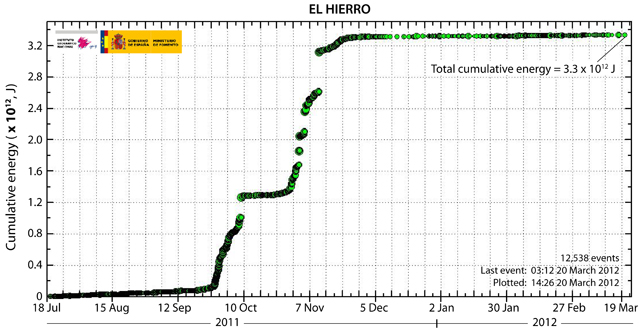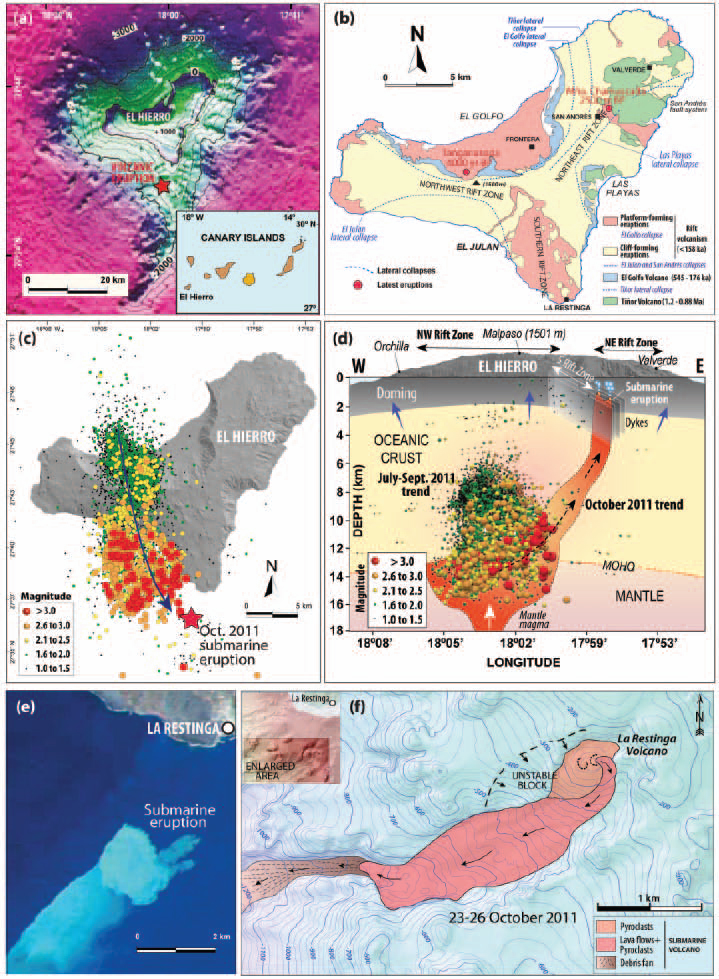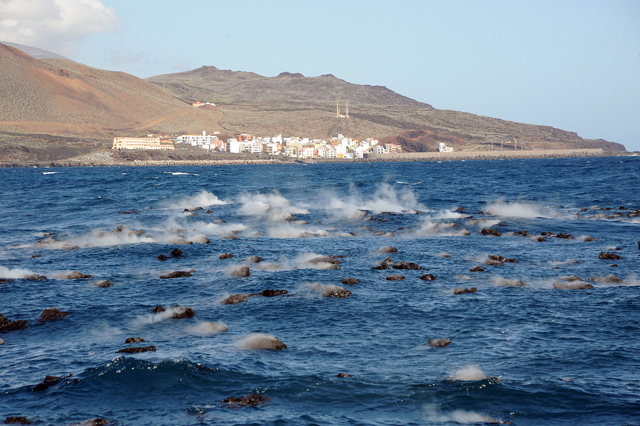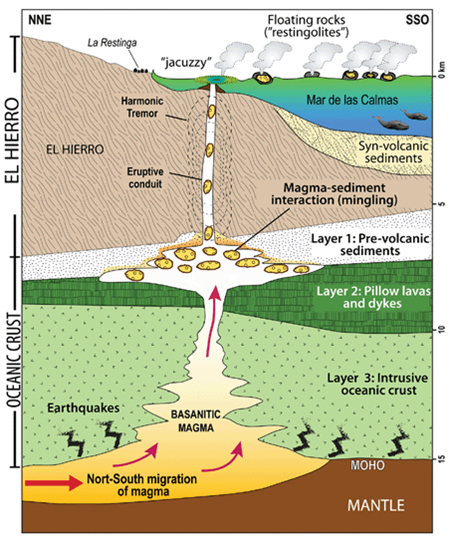Report on Hierro (Spain) — March 2012
Bulletin of the Global Volcanism Network, vol. 37, no. 3 (March 2012)
Managing Editor: Richard Wunderman.
Hierro (Spain) Update on submarine eruption
Please cite this report as:
Global Volcanism Program, 2012. Report on Hierro (Spain) (Wunderman, R., ed.). Bulletin of the Global Volcanism Network, 37:3. Smithsonian Institution. https://doi.org/10.5479/si.GVP.BGVN201203-383020
Hierro
Spain
27.73°N, 18.03°W; summit elev. 1500 m
All times are local (unless otherwise noted)
[NOTE: The location shown on the summary page is that for the main summit of Hierro volcano on El Hierro Island. The location of the submarine vent of Hierro that erupted beginning in October 2011 was found to be at latitude 27°37.18' N and longitude 17° 59.58' W.]
In BGVN 36:10 we discussed a submarine eruption of a vent of Hierro volcano that began in early October 2011 S of La Restinga, a town at the southermost tip of El Hierro Island (figure 7). The eruption was preceded by increased seismicity, although this seismicity declined significantly by mid-November 2011 (figures 8 and 9). Based on seismic activity monitored by the Instituto Geográfico Nacional (IGN-National Geographic Institute), authorities for the Canary Islands decided in late March 2012 to shut down the web cameras at La Restinga. Volcanic tremor was still present, although at minimal levels, and some seismicity continued beneath the island. The patch of brown water over the submarine vent (location shown in figure 8) continued to be observed throughout both March and April (figure 10).
Table 1. Background information on the six main Canary Islands and their volcanoes. Latest eruption dates are from Siebert and others (2010) and Smithsonian's Global Volcanism Program website. The volcano age indicates date of oldest volcanic rocks of each island (Carracedo and others, 2002).
| Volcano/island name | Location | Summit elevation (m) | Year(s) of latest eruption(s) | Volcano age (Ma) |
| Fuerteventura | 28.358°N 14.02°W | 529 | 1803-05 | 20.6 |
| Gran Canaria | 28.00°N 15.58°W | 1,950 | 1125 | 14.5 |
| Hierro/El Hierro | 27.23°N 18.03°W | 1,500 | 2011-12, 1793 | 1.12 |
| Lanzarote | 29.03°N 13.63°W | 670 | 1824, 1730 | 15.5 |
| La Palma | 28.57°N 17.83°W | 2,426 | 1971, 1949, 1712 | 1.77 |
| Tenerife | 28.271°N 16.641°W | 3,715 | 1909, 1798 | 11.6 |
Bathymetry and water chemistry. For 4 months following the eruption (a period from 22 October 2011 through 26 February 2012), the Instituto Oceanográfico Español (IOE-Spanish Oceanographic Institute) conducted 12 oceanographic cruise legs (called La Campaña Bimbache-Bimbache Campaign; Bimbache refers to native inhabitants of El Hierro), documenting the submarine morphology and water chemistry changes resulting from the eruption. Reports of these cruises on board the research vessel Ramon Margalef are found on the IEO web site; some highlights follow.
During the 7th leg, 8-12 January 2012, IEO scientists found that the volcano's summit was ~130 m below the water surface, 30 m more since its last survey on 2 December 2011. The diameter of the volcano's base was about 800 m, and its height ~200 m above the ocean floor. The total volume of material emitted since the eruption onset in October 2011 to the date of this cruise leg, calculated by bathymetry compared to 1998, was 145 x 106 m3. This volume included a new eruptive cone and associated lava flows. This new material nearly completely covered the W escarpment of the submarine canyon where the eruption was located. It was also found that a split in the top of the cone recorded in the bathymetric survey of 30 November 2011 no longer existed.
During the 9th leg, 6-8 February 2012, Hierro volcano was found to have grown somewhat more in height. The most significant differences between this and the 7th leg (January 2012) occurred at the top of the cone, including a slight increase in the elevation of its summit, which now reached to ~120 m below the water surface, and the emergence of a secondary cone, ~23 m high, attached to the side of the main cone, with a summit depth of 200 m. The emergence of the secondary cone and the greater mass of material on the volcano flank had caused a flattening of the structure. The slope ranged between 25° and 30° on the N flank, with slopes of up to 35° on the E and W flanks.
The 10th leg, 9-13 February 2012, was dedicated to water sampling. Observers found very high levels of hydrogen sulfide (H2.S), with a below normal pH, and very high partial pressure of CO2.
The IEO report of the 11th leg, 23-24 February 2012, notes that the coordinates of the main summit of the new volcano were: latitude 27°37.18' N and longitude 17° 59.58' W.
During a cruise from 5 to 9 April 2012 by researchers from IEO and the University of Las Palmas de Gran Canaria (ULPGC), 19 hydrographic stations were occupied. Data was collected on the physical-chemical properties of the water around the volcano (including temperature, salinity, depth, fluorescence, turbidity, dissolved oxygen, pH, alkalinity, total inorganic carbon, and CO2 partial pressure). The researchers intend to quantify the environmental impact caused by the volcano 7 months after the beginning of the eruption. The physical-chemical properties of the water column in an area of 500 m radius around the submarine volcanic cone where found to be still significantly affected. At this stage, the degassing of the volcano was fundamentally of CO2, with complete absence of sulfur compounds.
Remote submarine vessel observations. The University of Las Palmas de Gran Canaria (ULPGC) web site on 16 March 2012 reported initial filming of the submarine vent using the robot submarine vessel Atlantic Explorer. They reported particles of tephra in the mouth of the still-active vent. At a depth of 120 m, hot jets emerged from a vent, forming converging water convection cells reaching upwards to depths of ~40-60 m. From the same depths, some pyroclastic ejecta were seen in the form of large volcanic bombs. The SW flank of the main volcanic vent cone sloped steeply and was the resting place of many large pyroclastics, some of which are similar to the hollow volcanic bombs (lava balloons) that reached the ocean surface during November and December 2011. Marine life had returned to near the vent, and at a depth of ~170 m and under a rain of ash they observed a school of fish (possibly amberjack).
Geologic setting. Carracedo and others (2012a) provided further details on the geologic setting of El Hierro island and the 2011 vent eruption. They state that "As early as 1793, administrative records of El Hierro indicate that a swarm of earthquakes was felt by locals; fearing a greater volcanic catastrophe, the first evacuation plan of an entire island in the history of the Canaries was prepared. The 1793 eruption was probably submarine... over the next roughly 215 years the island was seismically quiet. Yet seismic and volcanic activity are expected on this youngest Canary Island due to its being directly above the presumed location of the Canary Island hot spot, a mantle plume that feeds upwelling magma just under the surface, similar to the Hawaiian Islands." Currently, roughly 10,000 people live on the island of El Hierro.
The report continued (references have been removed): "El Hierro, 1.12 million years old, is the youngest of the Canary Islands and rests on a nearly 3,500-m-deep ocean bed (figure 11a). According to stratigraphic data, two eruptions are known to have occurred on El Hierro, one ~4,000 years ago at Tanganasoga volcano complex and one 2,500 ± 70 years ago at Montaña Chamuscada cinder cone (figure 11b). The principal configuration of El Hierro is controlled by a three-armed rift zone system. The last stage of growth of El Hierro started some 158,000 years ago, characterized by volcanism that concentrated mainly at the crests of the three-armed rift system."
Carracedo and others (2012a) described the pattern of earthquakes detected by IGN's permanent seismic network. The pattern consisted of an event every few minutes and an average short-period body wave magnitude of about M 1-2. Though the most of these quakes were largely insignificant in terms of seismic hazards, they initially focused N of the island (figure 11c), concentrated within the lower oceanic crust at depths of 8 and 14 km, in agreement with petrological evidence of previous eruptions. The seismic and petrological data are thus in line with a scenario of a magma batch becoming trapped as an intrusion horizon near the base or within the oceanic crust. Shifting seismic foci suggested that magma progressively accumulated and expanded laterally in a southward direction along the southern rift zone, which caused a vertical surface deformation of ~40 mm based on GPS measurements.
The report continues: "Soon after the initial earthquake swarm was observed by the permanent seismometers associated with IGN, efforts were made to mobilize a more complete monitoring seismic and GPS array spaced roughly 2,000 m apart throughout the island. This expanded network, completely installed by September 2011, allowed scientists to follow the progress of the recent activity at El Hierro."
"The new instruments revealed that earthquakes and magma transport remained active but as of the beginning of October 2011 showed no sign of having breached the oceanic crust. Instead, magma continued to move south until, on 9 October, the magma apparently progressed rapidly toward the surface, as indicated by the first-time occurrence of shallow earthquakes (at depths of
"The eruption continued through 15 October, with the appearance of submarine volcanic 'bombs' with cores of white and porous pumice-like material encased in a fine coating of basaltic glass [figure 12; see figure 4 in BGVN 36:10 showing a cross-section view of a bomb]. These bombs are probably xenoliths from pre-island sedimentary rocks that were picked up and heated by the ascending magma, causing them to partially melt and vesiculate." According to Carracedo and others (2012b), "the interiors of these floating rocks are glassy and vesicular (similar to pumice), with frequent mingling between the pumice-like interior and the enveloping basaltic magma. These floating rocks have become known locally as 'restingolites' after the nearby village of La Restinga." Some 'restingolite' samples contain quartz crystals, jasper fragments, gypsum aggregates and carbonate relicts, materials more compatible with sedimentary rocks than with a purely igneous origin for the cores of the floating stones. Figure 13 shows one explanation for the formation these bombs.
2012 El Hierro Conference. A conference on the 2011-2012 submarine eruption will take place in the Canary Islands on 10-15 October 2012. The scientific program will cover a broad variety of topics related to volcanic risk management at oceanic island volcanoes and the balance between short-term hazards posed by volcanoes and benefits of volcanism over geologic time.
References. Carracedo, J-C., Perez-Torrado, F-J., Rodriguez-Gonzalez, A., Fernandez-Turiel, J-L., Klügel, A., Troll, V.R., and Wiesmaier, S., 2012a, The ongoing volcanic eruption of El Hierro, Canary Islands, Eos, Transactions, American Geophysical Union, v. 93, no. 9, pp. 89-90.
Carracedo, J.C., Torrado, F.P., González, A.R., Soler, V., Turiel, J.L.F., Troll, V.R., and Wiesmaier, S., 2012b, The 2011 submarine volcanic eruption in El Hierro (Canary Islands), Geology Today, v. 28, issue 2, pp. 53-58.
Carracedo, J.C., 2008, Canarian Volcanoes: La Palma, La Gomera and El Hierro, 213 pp., Editorial Rueda, Madrid.
Carracedo, J.C., Pérez, F.J., Ancochea, E., Meco J., Hernán, F., Cubas C.R., Casillas, R., Rodriguez, E., and Ahijado, A., 2002, Cenozoic volcanism II: The Canary Islands, in: The Geology of Spain, Gibbons, W., and Moreno, T., eds, The Geological Society of London, pp. 439-472.
Carracedo, J.C., Badiola, E.R., Guillou, H.J., de La Nuez, J., and Torrado, F.J.P., 2001, Geology and volcanology of La Palma and El Hierro, western Canaries, Estudios Geológicos, v. 57, no. 5-6, pp. 171-295.
Guillou, H., Carracedo, J.C., Torrado, F.P., and Badiola, E.R., 1996, K-Ar ages and magnetic stratigraphy of a hotspot-induced, fast grown oceanic island: El Hierro, Canary Islands, Journal of Volcanology and Geothermal Research, v. 73, no. 1-2, pp. 141-155.
Masson, D.G., Watts, A.B., Gee, M.J.R., Urgeles, R., Mitchell, N.C., Le Bas, T.P., and Canals, M., 2002, Slope failures on the flanks of the western Canary Islands, Earth-Science Reviews, v. 57, no. 1-2, pp. 1-35.
Siebert, L., Simkin, T., and Kimberly, P., 2010, Volcanoes of the World, Third Edition, Smithsonian Institution, Washington, D.C., and University of California Press, Berkeley, 551 pp.
Troll, V.R., Klügel, A., Longpré, M.-A., Burchardt, S., Deegan, F.M., Carracedo, J.C., Wiesmaier, S., Kueppers, U., Dahren, B., Blythe, L.S., Hansteen, T., Freda, C.D., Budd, A., Jolis, E.M., Jonsson, E., Meade, F., Berg, S., Mancini, L., and Polacci, M., 2011, Floating sandstones off El Hierro (Canary Islands, Spain): the peculiar case of the October 2011 eruption. Solid Earth Discussion, v. 3, pp. 975-999.
Viñuela, J.M., 2012, (online) The Canary Islands Hot Spot, www.mantleplumes.org/Canary.html, updated 21 December 2007, accessed 27 March 2012.
Geological Summary. The triangular island of Hierro is the SW-most and least studied of the Canary Islands. The massive shield volcano is truncated by a large NW-facing escarpment formed as a result of gravitational collapse of El Golfo volcano about 130,000 years ago. The steep-sided scarp towers above a low lava platform bordering 12-km-wide El Golfo Bay, and three other large submarine landslide deposits occur to the SW and SE. Three prominent rifts oriented NW, NE, and S form prominent topographic ridges. The subaerial portion of the volcano consists of flat-lying Quaternary basaltic and trachybasaltic lava flows and tuffs capped by numerous young cinder cones and lava flows. Holocene cones and flows are found both on the outer flanks and in the El Golfo depression. Hierro contains the greatest concentration of young vents in the Canary Islands. Uncertainty surrounds the report of an eruption in 1793. A submarine eruption took place about 2 km SSW off the southern point of the island during 2011-12.
Information Contacts: Alicia Felpeto Rielo, Instituto Geográfico Nacional (IGN), General Ibáñez de Ibero, 3. 28003, Madrid, España (URL: http://www.ign.es/); Volcano Discovery (URL: http://www.volcanodiscovery.com); Earthquake Report (URL: http://www.earthquake-report.com); University of Las Palmas de Gran Canaria (ULPGC) (URL: http://www.ulpgc.es); Canaries News (URL: http://www.canariesnews.com); Instituto Oceanográfico Español (IEO) (URL: htp://www.ieo.es).








